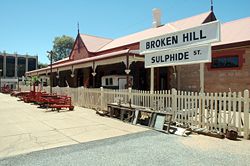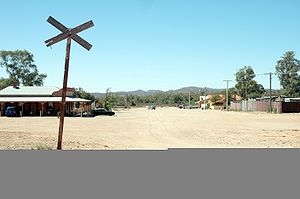
Silverton Tramway
Encyclopedia

Australia
Australia , officially the Commonwealth of Australia, is a country in the Southern Hemisphere comprising the mainland of the Australian continent, the island of Tasmania, and numerous smaller islands in the Indian and Pacific Oceans. It is the world's sixth-largest country by total area...
n 56 kilometres (34.8 mi) long narrow gauge railway running from Cockburn
Cockburn, South Australia
Cockburn is a town on the border of South Australia and New South Wales near Broken Hill. The town population consists of roughly 25 people with a greater regional community of 180 as of 2005.-Town history:...
on the South Australia
South Australia
South Australia is a state of Australia in the southern central part of the country. It covers some of the most arid parts of the continent; with a total land area of , it is the fourth largest of Australia's six states and two territories.South Australia shares borders with all of the mainland...
n state border to Broken Hill
Broken Hill, New South Wales
-Geology:Broken Hill's massive orebody, which formed about 1,800 million years ago, has proved to be among the world's largest silver-lead-zinc mineral deposits. The orebody is shaped like a boomerang plunging into the earth at its ends and outcropping in the centre. The protruding tip of the...
in New South Wales
New South Wales
New South Wales is a state of :Australia, located in the east of the country. It is bordered by Queensland, Victoria and South Australia to the north, south and west respectively. To the east, the state is bordered by the Tasman Sea, which forms part of the Pacific Ocean. New South Wales...
. Operating between 1888 and 1970 it served the mines of Broken Hill, and formed the link between the standard gauge New South Wales Government Railways
New South Wales Government Railways
The New South Wales Government Railways was the government department that operated the New South Wales Government's railways until the establishment of the Public Transport Commission in 1972. Although later known officially as the Department of Railways, New South Wales, it was still generally...
and the narrow gauge South Australian Railways
South Australian Railways
South Australian Railways built and operated railways in South Australia from 1854 to the incorporation of its non-urban railways into the Australian National Railways Commission in 1975, together with the former Commonwealth Railways and the former Tasmanian Government Railways...
. The line was owned and operated by the Silverton Tramway Company.
Inception
The Silverton Tramway was conceived as a way to transport ore from the newly discovered ore deposits at SilvertonSilverton, New South Wales
Silverton is a small village at the far west of New South Wales, Australia, 25 kilometres north-west of Broken Hill. At the 2006 census, Silverton had a population of 89 people....
, to the smelters at Port Pirie
Port Pirie, South Australia
-Transport:Port Pirie is located off National Highway One. It is serviced by an airport five minutes out of the city.- Railways :The first railways in Port Pirie were of the narrow [3' 6"] gauge....
, with the line later extended to Broken Hill with the discovery of that field. The need for a private line was in part due to the NSW Government refusing to allow the South Australian Railways to complete their narrow gauge link across the border. The Silverton Tramway Act was passed by New South Wales in 1886, permitting the narrow gauge line to be built. The Act also permitted the New South Wales government to buy out the company and assets after 21 years, provided a payment of 21 times the average of the previous seven years, and that the Company could be obliged to alter the track gauge at any time at its own expense. The line was built in twelve months at a cost of 125,000 pounds.

Steam locomotive
A steam locomotive is a railway locomotive that produces its power through a steam engine. These locomotives are fueled by burning some combustible material, usually coal, wood or oil, to produce steam in a boiler, which drives the steam engine...
s were owned by the company, along with 660 goods wagons. Passenger services were operated by the South Australian Railways, who paid the Company to access the line, the main passenger terminal in Broken Hill being at Sulphide Street. By the 1950s the Company was also providing a shunting service on 25 miles (40.2 km) of sidings in Broken Hill, and was also operating steam locomotives up to 62 feet (18.9 m) long and weighting 97 tons, ordered from Beyer Peacock at the same time as the WAGR W Class
WAGR W Class
The "W" class is a group of narrow gauge steam locomotives operated by the WAGR and Silverton Tramway Co Ltd.-Engineering Background:The Western Australian Government Railways "W" class steam locomotive was first proposed by Chief Mechanical Engineer Fred Mills in 1947...
locomotives. Diesel locomotive
Diesel locomotive
A diesel locomotive is a type of railroad locomotive in which the prime mover is a diesel engine, a reciprocating engine operating on the Diesel cycle as invented by Dr. Rudolf Diesel...
s were delivered from 1961, appearing in the yellow and blue colours some years later.
Gauge conversion
After the completion of the Trans-Australian RailwayTrans-Australian Railway
The Trans-Australian Railway crosses the Nullarbor Plain of Australia from Port Augusta in South Australia to Kalgoorlie in Western Australia...
, the Silverton Tramway and the South Australian line to Port Pirie
Port Pirie, South Australia
-Transport:Port Pirie is located off National Highway One. It is serviced by an airport five minutes out of the city.- Railways :The first railways in Port Pirie were of the narrow [3' 6"] gauge....
was a missing link in an unbroken Sydney
Sydney
Sydney is the most populous city in Australia and the state capital of New South Wales. Sydney is located on Australia's south-east coast of the Tasman Sea. As of June 2010, the greater metropolitan area had an approximate population of 4.6 million people...
to Perth
Perth, Western Australia
Perth is the capital and largest city of the Australian state of Western Australia and the fourth most populous city in Australia. The Perth metropolitan area has an estimated population of almost 1,700,000....
rail journey (Perth to Kalgoorlie, Western Australia
Kalgoorlie, Western Australia
Kalgoorlie, known as Kalgoorlie-Boulder, is a town in the Goldfields-Esperance region of Western Australia, and is located east-northeast of state capital Perth at the end of the Great Eastern Highway...
was the other). Moves towards conversion of the line to standard gauge were made with the passing of the Railway Standardisation Agreement Act of 1944, in which the New South Wales government would acquire the Silverton Tramway Company, then pass it to the South Australian Railway Commissioner. This agreement lapsed, with a new one made in 1949, in which the Commonwealth would be responsible for the acquisition.
The New South Wales government did not wish the Company to remain as a main line operator, or to purchase it themselves; while South Australian train crews were not happy to work trains across the state border due to a loss of favourable industrial conditions.. When the Company purchased its diesel locomotives, a number of structures, including bridges, were modified to carry standard gauge, as the company ordered the wider bogies needed to operate on standard gauge. By 1967 the Silverton Tramway Company offered to build a standard gauge line for a fixed sum, and transfer the line to New South Wales soon after. This line would run from Cockburn to Broken Hill on an alignment that had some interaction with the existing Crystal Street station, but the Commonwealth Government rejected it as they wished for the line to be built on a totally new alignment away from the Company lines. By 1968 South Australia believed that they would have gauge converted their portion of the line before the short section to Broken Hill was even finished.

Demise
The standard gauge line was finally opened in 1970 on a new alignment which led directly to the New South Wales-operated Crystal Street station, taking one year and over $2 million more than if the Silverton proposal was carried out. The Silverton Tramway Company's business was lost to the South Australian RailwaysSouth Australian Railways
South Australian Railways built and operated railways in South Australia from 1854 to the incorporation of its non-urban railways into the Australian National Railways Commission in 1975, together with the former Commonwealth Railways and the former Tasmanian Government Railways...
, with the company closing its narrow gauge shortline business, and returning the permanent way to the Crown.
The company then reinvented itself as Silverton Rail
Silverton Rail
Southern and Silverton Rail is an Australian regional rail operator providing rail freight haulage, hook and pull, terminal and shunting services, maintenance and first response/recovery services...
, a short haul rail operator servicing the mining industry in and around Broken Hill. Since 1886 the company hauled some 90 million tonnes of bulk and general freight and 2.8 million passengers over an aggregate of 19 million kilometres (12 million miles).
Further reading
- The Silverton Tramway (New South Wales). Light Railways (Summer 1968) Light Railways Research Society of Australia.

